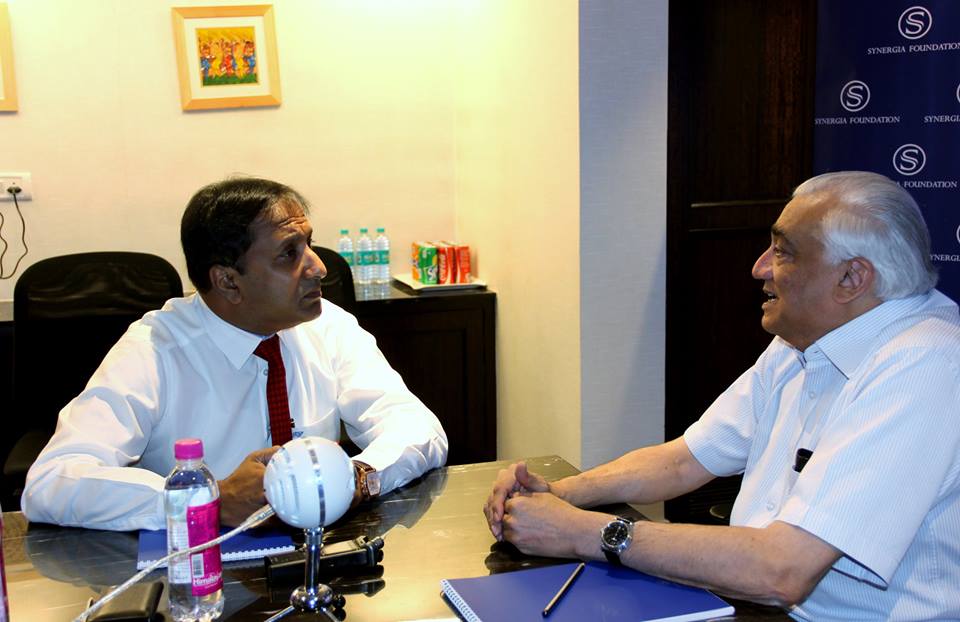Realignment in West Asia
June 13, 2017 | Expert Insights

Talmiz Ahmad, the former Indian Ambassador to Saudi Arabia, Oman and UAE was at Synergia Forum, on 10th June 2017 to discuss the current geopolitical narrative in West Asia. In his one -to- one interaction with Tobby Simon, the President of Synergia Foundation, he spoke about the new alignment of political forces in West Asia.
When asked about the current situation, the former Ambassador said that the key event, which has led to the current situation was mainly due to the ‘Arab Spring.’
The 2011 revolution challenged the ‘status quo’ in West Asia, a region that was home to authoritarian regimes and traditional monarchies. The monarchies increasingly faced challenges, as people were demanding more reforms. Any change would have both internal and regional ramifications. Saudi Arabia, in particular, tried to maintain their position by periodically demonizing Iran as a sectarian power.
The Struggle for Pre-eminence
One of the primary concerns of Saudi Arabia, was the steady expansion of Iranian influence in West Asia, extending beyond its borders to Bahrain, Syria, Iraq, and Yemen. Adding to the woes, Iran also follows a more independent energy policy due to its thrust on Liquefied Natural Gas (LNG).
After the fall of Saddam Hussein, Saudi Arabia has evolved as a regional superpower backed by the US and has maintained a certain ‘balance of power’ in the region. Mr. Ahmad contends that Saudi Arabia has hegemonic ambition in the region and considers it as an existential threat.
Qatar, a member of the Gulf Cooperation Council (GCC), has maintained good diplomatic ties with Iran, a locus-standi averred by Saudi Arabia. The current US intervention by President Trump has fundamentally altered the ‘security paradigm ’ in West Asia.
Former US President Obama had developed a distinct rapport with Iran by entering into a nuclear deal, ensuring higher optics for Iran as a regional power in West Asia. With the new Trump administration, there seems an emergence of closer ties between Saudi Arabia, Israel and the US & consequently Iran has been relegated as a regional threat.
With Trump at the helm, Saudi Arabia has reemerged as the key ally of the US in the Middle East. It has also entered into a 100 billion dollar military deal with the US to procure sophisticated hardware, keeping the powerful domestic armament industry in good stead.
Talmiz cautioned that the aggressive stance taken by Saudi Arabia with regard to Qatar has dangerous consequences. Essentially a zero sum game - where one could either lose everything or win everything.
The Shia and The Sunni
An intriguing development has been the coming of Turkey and Iran to Qatar’s rescue right after the diplomatic sanctions. The coming together of two of the most powerful Shia and Sunni countries in support of Qatar, itself a Sunni country, is disconcerting to the Saudis and may have upset the new security matrix it had planned for the region.
Turkey has fast-tracked its military deployment into Qatar, in the wake of the diplomatic standoff while Iran has offered to provide Qatar with food supplies. Turkey’s leveraging support to Qatar is a move that has not been inspired by singularly economic reasons. In terms of FDI (Foreign Direct Investment), UAE is the biggest contributor to Qatar.
Assessment
Inspite of Saudi Arabia’s efforts to form an axis against Iran, it is evident that Qatar has good diplomatic relations with the country. The two countries share exploration rights in the world’s largest gas field, located in the Gulf. The relationship between Qatar & Iran has been put to the test with the blockade. Our assessment is that larger economic interests will override short-term political considerations. The challenge will be that both Qatar and Saudi have rulers who are young and perceived as temperamental.








Comments